Happy to Hear That
Montclair audiology students offer hearing screenings to Pre-K and kindergarteners in community schools
Posted in: University
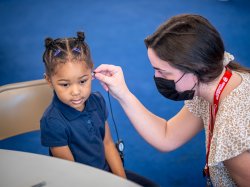
Skylah, a Pre-K student at a school run by The Leaguers, Inc. in Roselle, holds a paper cookie to her left ear. She’s wearing headphones attached to one of the portable audiometers the Montclair State University students and professors have brought to the school. Upon hearing a beep, the three-year-old gives the cookie to Quinley, the mouse from the children’s book If You Give a Mouse a Cookie, as instructed by Gita Balser, a second-year Montclair audiology student.
Nearby, first-year audiology student Grace Gleba works to get a 4-year-old boy to play a similar game as she checks his hearing. “If you hear a beep, throw the bean bag in the bucket, okay?” Gleba instructs him.
Jowel holds the bean bag to his left ear. But after the beep, nothing.
“Did you hear the beep?” He nods.
“Was it this ear or this ear?” Gleba asks, pointing to the red and blue headphones he’s wearing. He points to one ear, then the other. Audiology Clinic Director Faith Mogila steps in to help, challenging the boy to beat her at tossing the bean bag into the bucket. They continue working with him, ultimately determining that he can hear, he’s just quite shy. Jowel moves on to an otoscopic examination with first-year audiology student Max St. Germain.
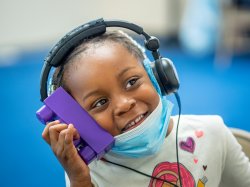
In all, on this day about 40 Roselle children will have their hearing screened using the audiometer and a visual ear examination with an otoscope. In addition, they will undergo an otoacoustic emission test, which involves placing a tiny device in the ear that emits sound and records an echo, measuring cochlear function. It’s commonly used with babies and small children because it doesn’t require a behavioral response from them.
The four Montclair students in Roselle are among 13 audiology doctoral students dispatched to three Early Head Start and Head Start programs run by The Leaguers, the oldest incorporated African American social service agency in New Jersey. The nonprofit organization provides services to 1,700 low-income families in Essex and Union counties. The hearing screenings, part of a partnership with the New Jersey Department of Health’s Early Hearing Detection and Intervention, provides a public service and gives audiology students hands-on experience. Audiology students in the University’s Department of Communication Sciences and Disorders also will provide hearing screenings to athletes participating in the Special Olympics New Jersey Summer Games in Ewing Township in mid-June.
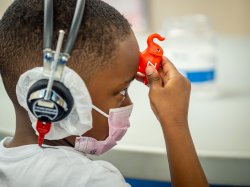
On this day, screenings are also taking place in Irvington and Newark – the same day news of Mattel’s release of a new Barbie with hearing aids was making the rounds among the students. The activities used during the screenings are meant to make the assessments more entertaining and less scary for children. Audiology students were challenged to come up with new age-appropriate activities that could be used to condition a child from 3-5 years of age. Gleba’s idea for the mouse-and-cookie activity, sparked by a trip to her mother’s basement where her mom still keeps all of her childhood toys, was approved for use. In fact, it was her stuffed mouse that was used at the Roselle school. At The Leaguers school in Newark, five Montclair students used toy elephants and building blocks to engage the children.
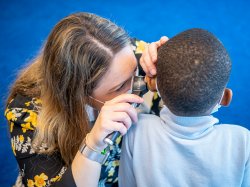
Second-year audiology student Sean Kleczkowski is conducting his first screening of young children in a preschool setting. “It’s really important to screen their hearing because they may be missing learning in class and not even know it,” Kleczkowski says.
While children are screened as newborns, as required by law, hearing issues can still develop. “They could have a late onset [or progressive] hearing loss,” Kleczkowski says. “Incidents of hearing loss can double between birth and age 6, so it’s crucial that we do these screenings.”
Ivonne Jaramillo, a health and nutrition specialist with The Leaguers, said she and other specialists typically travel to schools to do hearing and vision screenings at the beginning of the school year, as required by the school, but that having an additional follow-up screening is also good. “It’s important because we want early intervention,” Jaramillo says. “Not being able to hear could interfere with school productivity.”
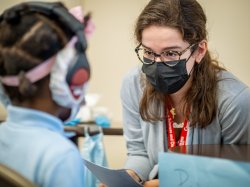
Pre-K teacher Mariam Gonzales monitors the proceedings as some of her preschoolers get tested while others await their turn. She’s optimistic that they will pass the screening. “I haven’t had any problems with them not hearing me in the classroom,” she says.
Parents, who provided consent for the screenings, will receive letters explaining their children’s results. Any student who doesn’t pass the screening will be referred to their pediatrician and an audiologist in their area. The parents of all the children tested will also receive literature explaining the importance of screening and signs of normal speech and language development.

At The Leaguers’ Early Head Start and Head Start programs in downtown Newark, first-year audiology student Vanessa Coppola says she enjoyed testing the children, “It was a lot of kids and a lot of experience screening children.” Some, she says, will need follow-up testing.
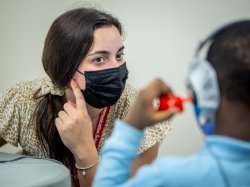
While Balser, second-year student Cindy Fernandez and third-year student Rosie Ovadia had tested young children before, more often than not these screenings are the first opportunity for Montclair audiology students to screen children, says Mogila.
At Montclair’s audiology clinic, the students work mostly with adults who are in a soundproof booth. At the Newark school, “it was interesting,” says Nicole Genser, a first-year student. “We had to think about the best way to set it all out in terms of environment and noise. The kids were great.”
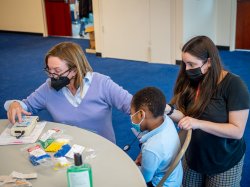
Professor Joan Besing, director of Clinical Graduate Programs in the Department of Communication Sciences and Disorders, says going to schools sometimes affords Montclair students new experiences. “There were some students who had tubes in their ears, our students hadn’t seen that before. It provides them with hands-on experience so that they become more comfortable.”
There’s also the added bonus of giving back while also learning. “It’s really rewarding to be able to do screenings for one’s community,” says Fernandez. “We’re applying our knowledge for the better good.”


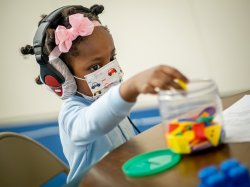
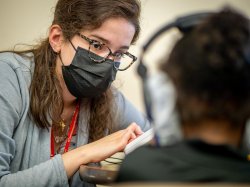
To learn more about the doctorate of audiology program visit Audiology.
Story by Staff Writer Sylvia A. Martinez. Photos by University Photographer Mike Peters.
